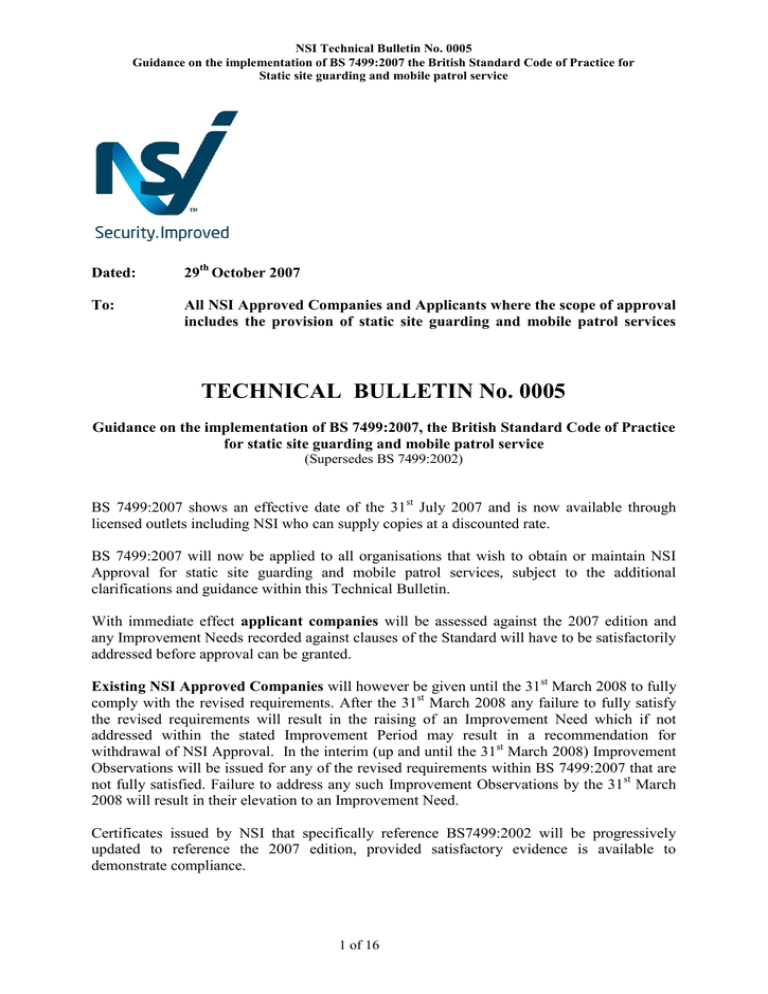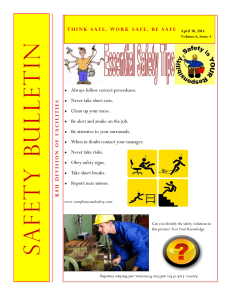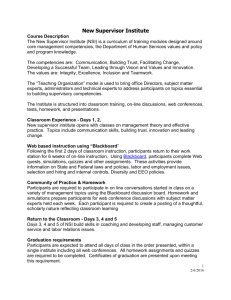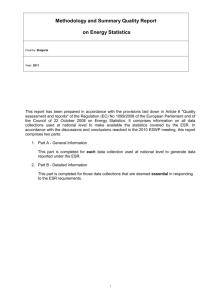TECHNICAL BULLETIN No. 0005
advertisement

NSI Technical Bulletin No. 0005 Guidance on the implementation of BS 7499:2007 the British Standard Code of Practice for Static site guarding and mobile patrol service Dated: 29th October 2007 To: All NSI Approved Companies and Applicants where the scope of approval includes the provision of static site guarding and mobile patrol services TECHNICAL BULLETIN No. 0005 Guidance on the implementation of BS 7499:2007, the British Standard Code of Practice for static site guarding and mobile patrol service (Supersedes BS 7499:2002) BS 7499:2007 shows an effective date of the 31st July 2007 and is now available through licensed outlets including NSI who can supply copies at a discounted rate. BS 7499:2007 will now be applied to all organisations that wish to obtain or maintain NSI Approval for static site guarding and mobile patrol services, subject to the additional clarifications and guidance within this Technical Bulletin. With immediate effect applicant companies will be assessed against the 2007 edition and any Improvement Needs recorded against clauses of the Standard will have to be satisfactorily addressed before approval can be granted. Existing NSI Approved Companies will however be given until the 31st March 2008 to fully comply with the revised requirements. After the 31st March 2008 any failure to fully satisfy the revised requirements will result in the raising of an Improvement Need which if not addressed within the stated Improvement Period may result in a recommendation for withdrawal of NSI Approval. In the interim (up and until the 31st March 2008) Improvement Observations will be issued for any of the revised requirements within BS 7499:2007 that are not fully satisfied. Failure to address any such Improvement Observations by the 31 st March 2008 will result in their elevation to an Improvement Need. Certificates issued by NSI that specifically reference BS7499:2002 will be progressively updated to reference the 2007 edition, provided satisfactory evidence is available to demonstrate compliance. 1 of 16 NSI Technical Bulletin No. 0005 Guidance on the implementation of BS 7499:2007 the British Standard Code of Practice for Static site guarding and mobile patrol service NOTE REGARDING THE STATUS OF BS 7499:2007: Although issued as a Code of Practice by the British Standards Institution, compliance is regarded as mandatory for all organisations wishing to maintain NSI Approval for static site guarding and mobile patrol services, subject to any additional clarifications and guidance included within this Technical Bulletin or subsequently issued. SUMMARY OF SIGNIFICANT CHANGES (Highlighted under the clauses of the new Standard) Each significant change introduced by BS 7499:2007 (as compared with the 2002 edition) is addressed under the relevant clauses as detailed below on the following pages. Where the actual text from BS 7499:2007 is quoted it is reproduced in bold text and where it is considered appropriate, further guidance in italics has been provided. It is not, however, the intent of NSI to impose its own preferred methods of compliance with specified requirements and NSI will give full consideration to any alternative methods of achieving compliance with specified requirements. FOREWORD The structure of the Foreword has changed. There is now a section on presentational conventions that makes it clear that the recommendations within the Standard are expressed in sentences in which the principal auxiliary verb is “should”. However for approval under the NSI Scheme the above note regarding the status of BS 7499:2007 makes it clear that the requirements of BS 7499 are mandatory. Therefore, all references to “should” within the Standard must be read as “shall” as they are not an option. Some clauses within the Standard use the word “may”; unless it is stated otherwise under the relevant clause, it is accepted that such references act as an alternative to the primary requirement. The reference to the Private Security Industry Act 2001 is retained principally to draw attention to the fact that individuals carrying out licensable activities as defined in the Act are required to be licensed. Organisations wishing to maintain NSI Approval need to be able to demonstrate that all relevant deployed personnel hold the appropriate SIA Licence or, if they are a SIA Approved Contractor, that they are covered by a Licensing Dispensation Notice. 1. SCOPE The only changes to the scope are to replace the term “manned guarding” with the more politically correct “security guarding” and to include a reference to a new informative Annex A to define what constitutes security guarding as defined in the Private Security Industry Act 2001. 2. NORMATIVE REFERENCES The only changes are to update the references for relevant British, International or European Standards. 2 of 16 NSI Technical Bulletin No. 0005 Guidance on the implementation of BS 7499:2007 the British Standard Code of Practice for Static site guarding and mobile patrol service 3. TERMS AND DEFINITIONS Minor changes have been made to some of the existing definitions. Some additional definitions have been added as indicated below: 3.1 Assignment Instructions. The previous definition referred to an operational document detailing specific contractual duties, whereas the new definition refers to site specific contractual duties. 3.7 Keyholding. The definition has been slightly reworded and now reads “service whereby the organisation holds keys to a customer’s premises and/or equipment for use as agreed in the contract”. 3.8 Mobile patrol. The definition has been redefined as “security services provided by security officers travelling to multiple sites physically distant from one another, within a defined period of time”. 3.9 Organisation. The reference to manned guarding has been dropped and the definition now reads “sole or main provider of static site guarding and/or mobile patrol services to a particular customer”. 3.10 Principal. A new definition that reads “owner, partner, board director or other top executive in the private sector, or an executive officer in the public sector or a not-for-profit organisation”. 3.12 Security officer. The reference to a trained person has been dropped, such that the definition now reads “person who performs duties at a static site or on a mobile patrol”. 3.13 Static site. The emphasis is now on a fixed location and a fixed length of time such that it reads “fixed location or premises to which a security officer is assigned for a fixed length of time”. 4. THE ORGANISATION 4.1 Structure The organisation should now possess rather than publish a clearly defined management structure showing control and accountability at each level of operation. NSI Approved Companies shall document their management structure ideally in the form of an organisational chart that clearly shows the reporting relationships and it shall also be clear who the current incumbents are. The defined management structure shall also be communicated to all relevant personnel within the organisation and the organisation shall ensure that individuals are aware of their responsibilities, authorities and accountability. 3 of 16 NSI Technical Bulletin No. 0005 Guidance on the implementation of BS 7499:2007 the British Standard Code of Practice for Static site guarding and mobile patrol service 4.1 Structure (Continued) The reference for a complaints management system has been updated to reference ISO 10002 (previously referenced BS 8600 which has been withdrawn). NSI Approved Companies do not need to fully comply with all the guidance within ISO 10002 provided they are compliant with the NSI Code of Practice NCP 5 for the management of customer complaints (historically NCP 5 was only applied on the NSI NACOSS Scheme but it is now being progressively applied across all NSI Schemes). A note has now been added at the end of the clause on disclosure of unspent convictions to draw attention to the Rehabilitation of Offenders Act 1974. 4.2 Finances There is a minor change in the second paragraph with regard to financial backing for Organisations that cannot yet present two year’s audited accounts. Substantial backing is now replaced with adequate financial backing. The NSI view on adequate financial backing is to view the resources, financial projections and available balance sheets at the application stage in order to take a view whether the organisation has the resources to finance its current and projected customer base, particularly if there are any delays in payment of invoices for contracted services. When forming its view, NSI may take account of the extent and nature of past business experience of the Principles of the company. 4.3 Insurance Some minor re-wording but no substantive change to the insurances to be maintained. 5. RESOURCES 5.1 Premises No significant change to the requirement to have an administrative office(s) but inclusion of an additional sentence stressing that “The location of records and documentation, both local and centralised, should be clearly defined by the organisation”. Organisations wishing to maintain NSI Approval shall clearly define the documents to be retained, their minimum retention period and the location/function where they are to be retained. The address of the relevant administrative office(s) shall also be used on all correspondence, promotional material and signage. 4 of 16 NSI Technical Bulletin No. 0005 Guidance on the implementation of BS 7499:2007 the British Standard Code of Practice for Static site guarding and mobile patrol service 5.2 Control Room 5.2.1 Design No change to the requirements. BS 7499 Control rooms are restricted areas open only to authorised personnel and consequently where persons, other than those assigned to and directly delivering (or managing) designated control room activities enter the control room, they should sign in and out in a visitor book or similar. The records shall be used to record, for example, visits by other employed (not designated control room staff, or un-rostered control room staff), external visitors, contractors, law enforcement agencies and inspectors/auditors. 5.2.2 Location No change to the requirements. 5.2.3 Construction This clause remains unchanged in this standard with the exception of: a) Paragraph 8. The reference to BS 4737-1 for a 24 hour remote-signalling intruder alarm system is updated to reference its replacement BS EN 50311/PD6662. b) Paragraph 10. The requirement for protection of glazed areas is now qualified to show that it only relates to external or publicly accessible glazed areas. 5.2.4 Facilities a) Paragraph 1. The reference to BS 4737-2 for a deliberately operated remote-signalling alarm system has been updated to BS EN 501311/PD6662. b) The requirement for strongly constructed and securely mounted lockable key cabinets has changed to “strongly constructed, secure, lockable storage should be provided for customer keys”. The change allows for a greater degree of flexibility without necessarily compromising the security e.g. keys sealed to rings around the wall of a secure locked room with appropriate access control would now clearly be acceptable even if they were not contained in individual cabinets within the secure room. 5.2.5 Procedures a) Paragraph 3. A hard copy of the Control Room Manual should now be readily available within the Control Room. 5 of 16 NSI Technical Bulletin No. 0005 Guidance on the implementation of BS 7499:2007 the British Standard Code of Practice for Static site guarding and mobile patrol service The introduction of a requirement to maintain a hard copy of the manual is very prescriptive. NSI recognises that there may be legitimate reasons for a company to prefer to rely on electronic copies only, though there would need to be suitable safeguards. NSI has therefore written to British Standards Institution, asking the Committee responsible for BS 7499 to review sub-clause 5.2.5. In the meantime, as an interim position pending the outcome of this review, NSI will consider arguments from companies for relying on electronic copies only. For example, if only electronic copies are to be available, it would need to be clear that all control room staff have ready access to an appropriate terminal, and that they are instructed on how to callup the manual. Also, there would need to be a means of ensuring that the manual remains accessible in the event of the local computer network going "down", and also in the event of catastrophic power failure; for example this may be achieved by making permanently available within the control room a battery-powered laptop computer carrying the manual within its own internal "memory. b) Paragraph 5. The paragraph on check calls has been expanded such that there is now more guidance on the basis for deciding the frequency of check calls and a specific requirement to verify that automated systems are still working has been incorporated. The paragraph now reads: “Check calls from security officers should be received and recorded at the control room at intervals specified in their assignment instructions. The control room manual should detail the procedures to follow and actions to be taken in the event of a late and missed check call. The frequency of check calls should be determined following a health and safety risk assessment, and should take into account the number of security officers on duty. Procedures for daily verification that automated systems are working should be detailed in the control room manual and verifications should be documented”. NSI now expect to see a detailed documented procedure that clearly establishes the checks or verifications that now have to be carried out on a daily basis to verify that any automated system is still working and records that show that such checks are carried out. 5.2.6 Information A new paragraph a) has been added and paragraph h)(now i) has been modified. Paragraph a) now requires the controller to have immediate access to all assignment instructions. This requirement was virtually dropped in the 2002 edition in favour of just having certain basic site information immediately available but it has now been reinserted. Where the established format for assignment instructions includes a number of standard attachments it will not be necessary to have them attached to all copies of assignment instructions provided a master set is available for immediate reference. 6 of 16 NSI Technical Bulletin No. 0005 Guidance on the implementation of BS 7499:2007 the British Standard Code of Practice for Static site guarding and mobile patrol service Paragraph i) now requires emergency procedures and contingency plans in the case of fire, flood or bomb threat etc, for the control room and other premises. It was previously understood that the requirement only related to the Control Room but it is now clear that it relates to any other premises maintained by the organisation that are involved with the provision of the static site guarding and mobile patrol services. Emergency procedures and contingency plans for contracted sites shall be covered in the site specific assignment instructions as agreed with the client. It is also recommended that the contingency planning arrangements for the control room should be regularly tested, including the provision of emergency response arrangements to enable the service to be maintained during an emergency. 5.2.7 Records No significant change except to change the reference to ‘shift leaders’ to ‘controllers’. 5.2.8 Personnel No change. 5.3 Staff 5.3.1 General No change. 5.3.2 Selection and screening This section still requires all persons undertaking, or having access to details of, security duties, to be selected and screened in accordance with BS 7858 but it has been rewritten and some of the requirements previously included under 5.3.3 modified and incorporated. The essential changes are that: - If employees are acquired through a takeover, the organisation should satisfy itself that the recommendations of this sub clause have been fully met. - The requirement for an annual check on driving licences has been replaced by a requirement for a six-monthly inspection of the same. 7 of 16 NSI Technical Bulletin No. 0005 Guidance on the implementation of BS 7499:2007 the British Standard Code of Practice for Static site guarding and mobile patrol service 5.3.3 Health As mentioned in the preceding clause, some of the requirements previously addressed under this clause are now included under clause 5.3.2. In order to comply with age discrimination legislation the requirement for persons over 65 years of age to have an annual medical has been dropped and replaced by the following requirement: Where health and safety risk or medical concerns of personnel are raised, it is reasonable for a company to ask that person to undergo a medical examination to ensure fitness for duty. 5.3.4 Terms and conditions of employment No change. 5.3.5 Disciplinary code The only change is to add item 5 to clause l) to reflect the SIA Licensing requirements i.e. failure to notify the employer immediately of any refusal, suspension or withdrawal (revocation) of a Security Industry Authority (SIA) licence also now constitutes a breach of the terms and conditions of employment. 5.3.6 Identification The applicability of this section has been slightly changed in that it previously stated that it applied to employees who have been screened, whereas it now refers to employees, who are required to be screened. There is also the incorporation of a note at the end of the section, as follows: Where a security officer is required to display a SIA licence this does not negate the need for company identification. 5.4 Equipment and Uniforms 5.4.1 Uniform No change. 5.4.2 Vehicles 5.4.2.1 General No change. 8 of 16 NSI Technical Bulletin No. 0005 Guidance on the implementation of BS 7499:2007 the British Standard Code of Practice for Static site guarding and mobile patrol service 5.4.2.2 Vehicles Carrying Keys The only change is to delete the requirement for the vehicle alarm to comply with BS 6803-3. 5.4.3 Other equipment No change. 5.4.4 Equipment records No change. 5.5 Training 5.5.1 General No change. 5.5.2 Induction training No change. 5.5.3 Basic job training: The core requirements for basic (classroom) training have been modified and extended such that they are comparable with those issued by the Sector Skills Body (SSB) and are also therefore comparable with the competency requirements that have to be satisfied in order to obtain a SIA Security Guarding (SG) licence. The training is required to last at least 32 hours, including the examinations. The requirement to include additional hours for subject specific modules that relate to the role to be undertake, is retained e.g. although a SIA SG Licence covers uniformed retail guarding it is also appropriate to include an additional module that focuses on the specific risks that can be faced in a retail environment. 5.5.4 Assignment specific training No significant change except that the NTO (National Training Organisation) reference has been replaced by the SSB (Sector Skills Body). It should be emphasised that this section still contains two very important and specific requirements which are not always given the attention that they deserve i.e. the need to deliver site specific assignment training on all sites and the need to carry out a performance assessment within three months for new employees. 9 of 16 NSI Technical Bulletin No. 0005 Guidance on the implementation of BS 7499:2007 the British Standard Code of Practice for Static site guarding and mobile patrol service 5.5.5 Control room training No change. 5.5.6 Supervisory training No change. 5.5.7 Specialist training No change. 5.5.8 Training exemption and transferability of qualifications No significant change but a note is added to remind readers that SIA Licensing requirements apply if working in licensable activity. 5.5.9 Takeovers No change. 5.5.10 Refresher Training No change. . 5.5.11 Contingency Training No change 5.5.12 Vocational Training Slight rewording but no significant change. 5.5.13 Training Records No significant change. 5.6 Suppliers 5.6.1 Suppliers of subcontract labour No change. 5.6.2 Qualifications of suppliers’ personnel The list of items to be satisfied when using subcontractors now includes item f) a requirement to ensure that subcontractors are appropriately licensed by the SIA. 10 of 16 NSI Technical Bulletin No. 0005 Guidance on the implementation of BS 7499:2007 the British Standard Code of Practice for Static site guarding and mobile patrol service 5.7 Documents and data The basic requirements are unchanged but the references for the management of electronic data have been updated to include BS ISO/IEC 27001 and the minimum retention time for employees’ basic records has been reduced from 10 to 7 years in order to fall in line with BS 7858:2006. 6.0 SERVICE 6.1 Sale of services 6.1.1 Contacting prospective customers No change. 6.1.2 Customer information No change. 6.1.3 Quotations No change to the requirements previously included under clause 6.1.4. 6.1.4 Quotations for mobile patrol services No change to the requirements previously included under clause 6.1.5. 6.1.5 Contracts No change. 6.1.6 Contract records No change to the requirements previously included under clause 6.1.7 6.2 Initial site inspections A new section has been added to clarify the requirements for the initial site inspection and it includes the following clauses: Prior to commencement of a service, the organisation should undertake an initial site inspection. A report should be made, identifying any health and safety and security risks that security officers could face in carrying out the service, and presenting information useful for production of assignment instructions. 11 of 16 NSI Technical Bulletin No. 0005 Guidance on the implementation of BS 7499:2007 the British Standard Code of Practice for Static site guarding and mobile patrol service Organisations are reminded that under health and safety legislation they are still responsible for the health & safety of their officers even though they are deployed on the clients site. NSI expect to see that there is a documented risk assessment for each contracted site that addressses both generic and site specific risks and that there is a method of assessing both the probability of the risk and its significance. The control measures necessary to control the risk should also be clearly stated and the risk assessments should be carried out by competent personnel. A competent person should conduct initial site inspections and records should be maintained to confirm that all relevant aspects have been considered. If possible, the report should form part of the proposal to the customer; however, it should be made clear that it is not intended to be a full assessment and recommendations for the overall security of a site. If the customer declines to have initial site inspections conducted, a letter should be obtained, or notes from a meeting with the customer should be produced, confirming this. In these cases, an assessment should be made by the organisation to ensure that health and safety requirements are complied with. Where existing assignments are taken over, the organisation should discuss with the customer and the previous service provider any implications with respect to current employment legislation. Areas to focus on are the aspects covered by the Working Time Regulations e.g. shift durations, rest periods, night time working etc and the SIA licences required. It is clearly not acceptable to flout any aspect of legislation on the basis that the practices are based upon those taken over from a previous security contractor. It is however recognised that where officers have TUPE’d across any necesarry changes to their original terms and conditions of employment will require sensitive handling. 6.3 Assignment Instructions (clause 6.2 in the previous edition) 6.3.1 General No change. 6.3.2 Content No significant changes. 6.3.3 Amendments No change. 12 of 16 NSI Technical Bulletin No. 0005 Guidance on the implementation of BS 7499:2007 the British Standard Code of Practice for Static site guarding and mobile patrol service 6.4 Static Sites 6.3.1 Information No significant change. 6.4.2 Duties The lead-in sentence previously stressed that the principal responsibility of a security officer should be to protect property, this has now been expanded include the ‘customers people, property and assests’. 6.4.3 Site records There is a slight change of emphasis in that ‘a daily register should be maintained of all assignments’, the previous edition stated on all assignments. Although the list of requirements to be recorded will in most instances still be best satisfied by on-site records, NSI will now accept that such records could be maintained centrally in a control room/communications centre as an alternative. An additional requirement has also been included for the recording of incidents i.e. item 2) nature of the incident (i.e. fire, flood or theft). 6.4.4 Static site performance monitoring The previous clause 6.3.4 on site supervision is now split into two new clauses i.e. 6.4.4 Static site performance monitoring and 6.4.5 Staff visits and there is sufficient change of emphasis to warrant the inclusion of further guidance against each requirement, as follows: Each static site should have a written plan for regular supervisory/management visits. A qualified person who is independent of the running of that static site should undertake the visits that should include checks on : a) the validity of the assignment instructions; b) the satisfactory maintenance of records. Note 1:- The visit might also include items as detailed in 6.4.5. There should be clearly defined procedures for management follow-up to incidents and for response and support to security officers if incidents occur. Each manager responsible for a portfolio of contracted sites should ideally maintain a plan or spreadsheet detailing the mimimum frequency of visits to 13 of 16 NSI Technical Bulletin No. 0005 Guidance on the implementation of BS 7499:2007 the British Standard Code of Practice for Static site guarding and mobile patrol service each site which should be based upon due consideration of the complexity of the duties carried out and the nature of the business conducted by the customer. As the visits are carried out they should be recorded so that it is easy to establish if there are sites that have not been visited for some time. Requirements for recording findings on such visits should be clearly defined and a documented procedure should be maintained to cover the reporting and closure of any adverse findings or actual incidents. Even if there is an on-site manager, there should still be a level of independent visits although the frequency of such visits may be less than that required for sites where there is site management. If the security officer does not contact the control room on time, as specified in the assignment instructions, the supervisor should be notified and a visit to the static site should be made or the relevant escalation procedure implemented. NSI require to see detailed check call and escalation procedures within the control room manual that demonstrate adequate care and protection for security officers, particularly those that could be classified as lone workers. In particular, if the control room cannot contact the security officer on a reverse call than an escalation procedure should be initiated that shall ensure there is a timely response to verify that the officer is not in need of urgent assistance. Where a site visit is necessary, personnel tasked with responding shall be asked for their estimated time of arrival and if it is excessive, alternative resources should be considered. Such instances shall not be closed out until contact with the officer is confirmed. A formal minuted meeting should take place with the customer to discuss contract performance against both the contract and the assignment instructions. Note 2. Additional information such as Key Performance Indicators (KPI’s) and Service Level Agreemments (SLA’s) could aid the review process. The frequency of the meetings should be documented and subject to agreement by both parties. Copies of the minutes should be retained on the customer file. The frequency of such visits will generally be dictated by the customer and even if the customer does not specify a SLA and relevant KPI’s it may convince the customer that they are dealing with a professional organisation if evidence of actual performance can be presented against sensible KPI’s covering such items as staff turnover, blowouts, number of times relief officers had to be rostered etc. Records of monitoring should be available for inspection by the customer. Where static sites are monitored by mechanical or electronic clocking systems, records of transactions should be made available for inspection by the customer upon request. 14 of 16 NSI Technical Bulletin No. 0005 Guidance on the implementation of BS 7499:2007 the British Standard Code of Practice for Static site guarding and mobile patrol service Where such systems provide evidence as to the adequacy and duration of the patrols, they shall be subject to review by either the site based security manager or the visiting management/supervision and a sufficient history of records maintaned to indicate whether performance is improving or deteriorating. The customer may also need to be consulted for their views on the minumum retention time for such information. 6.4.5 Staff visits The requirements for staff visits and performance appraisals have both been strengthened as follows: Each security officer should receive a visit once per month from either the static based supervisor/manager or a supervisor/manager from the organisation. Items to be covered each month should include the following: a) welfare; b) familiarity with assignment instructions; c) performance; d) training needs. A supervisory/manager staff visit report should be completed, signed by the security oficer and filed on the security officers file. NSI will not insist on the completion of an individual report for each officer or that it is always filed in the security officer’s file. For example, if the form utilised has provision to clearly record the findings for each officer interviewed on a management visit to a particular site, a tick-box style can be utilised to indicate compliance with specified requirements for the team as a whole as long as there is provision to then individually record any welfare, training or performance issues and comment in more depth on any adverse findings. The form utilised should also be signed by supervisor/manager and have provision for closing out any actionable points. Filing of staff visit reports may be by contract or site so that it is also easier to see any repetitive site issues as well as any officer trends. Annually, a performance appraisal should be carried out, the appraisal form should be signed by the officer and filed on the security officer’s file. Performance appraisals should: 1) be carried out by supervisors/managers with appropriate skills and training in appraisal and people development; 2) be a two-way, confidential and private discussion between supervisor/manager and security officer; 3) focus on past performance (to confirm actions completed and recognize improvements), as well as future needs to improve performance; 4) ideally include both positive and negative feedback from other security officers and customers; 15 of 16 NSI Technical Bulletin No. 0005 Guidance on the implementation of BS 7499:2007 the British Standard Code of Practice for Static site guarding and mobile patrol service 5) identify relevant objectives (e.g. KPI’s, personal development objectives) with achievable targets; 6) encourage self-learning and development; 7) encourage those with potential to access opportunities to progress within the organisation and to identify and encourage future leaders; 8) be scheduled to take place at an agreed time, ideally away from the normal place of duty and when operational activities can be temporarily covered by another security officer. 6.5 Mobile patrol services Mobile patrol services were previously referenced under clause 6.4. 6.5.1 Information The only significant change is as follows: Security officers whilst on a mobile patrol visit should have access to (previously carry) assignments instructions for each site to be visited. 6.5.2 Duties A further sentence has been added as follows: Additional check calls should be made to ensure that the frequency between calls is no more than 1 hour. The above has been incorporated to cover situations where the arrival on the next site could be over one hour after the departure from the previous site. 6.6 Control of keys (previously 6.5) 6.6.1 General The only change is to the retention period for records of unclaimed keys, which has been increased from 6 to 7 years. 6.6.2 Keys on static sites No change. 6.6.3 Keys on mobile patrols The BS 4737-1 reference for the remote-signalling intruder alarm has been updated to BS EN ISO 5031-1/PD 6662 and the twice weekly check on the keys has been reduced to at least a weekly check. 16 of 16





